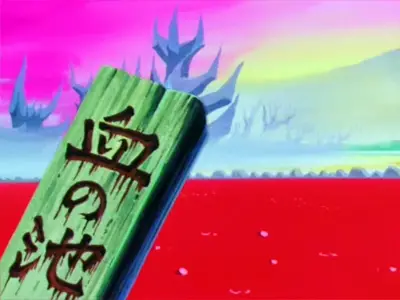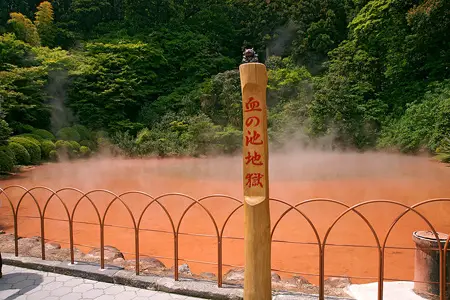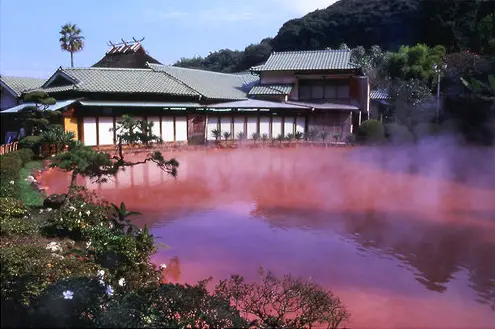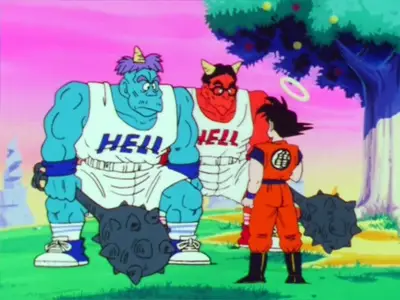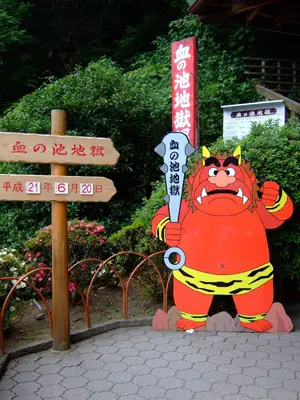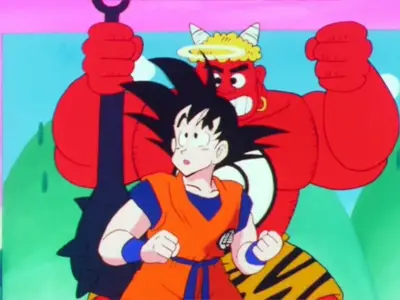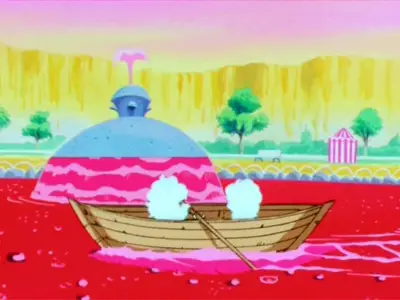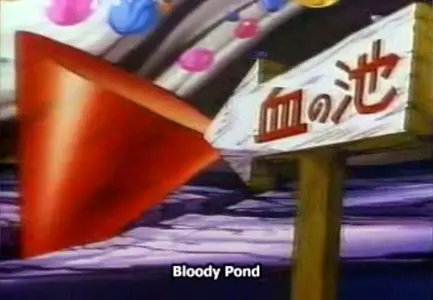Dragon Ball’s Bloody Pond of Hell
Have you been to the Bloody Pond of Hell? It’s a great place to visit… They have row boats.
Many fans of Dragon Ball may be aware of the Bloody Pond in Dragon Ball’s Hell, but how many of them know that you can actually visit it?
It turns out that there is a real Bloody Pond in a city of Japan, and that it was the most likely source for Dragon Ball’s version.
This Bloody Pond also has an interesting part to play in traditional Japanese culture and society.
What is the Bloody Pond and why does this matter in Dragon Ball? And where exactly did Toriyama receive the inspiration for his Bloody Pond?
The Red Hot Boiling Blood of Hell
The Chinoike Jigoku (Bloody Pond Hell) is a hot spring located in Beppu City, Oita Prefecture, Japan, and is one of Japan’s oldest, dating from as early as 700. A.D.
The Chinoike Jigoku’s (pronounced “Chee-no-eekay Jee-goh-ku”) most notable feature is its blood red water that boils at over 200 °C.
The blood red water appears to have led the Japanese people to believe it was a type of Hell erupting forth from down below. Their version of Hell in this case is one derived from the Buddhist belief system, which believes in multiple layers of Hell’s, each with a different nature.
In Beppu City there are 8 other hot spring attractions, each with a distinct nature, such as boiling grey mud, hot blue water, milky water, or a hot geyser that erupts every 25-30 minutes.
Why is this one blood red? The pond is blood red because of the high iron oxide (hematite) content in the sediment deposited at the bottom of the pool. (Interestingly the word hematite is derived from the Greek word for blood.) In this case, the red color of the iron fills the water and makes it change color, and when you combine this with boiling temperatures it looks like a scene from Hell.
The Bloody Pond has been a famous tourist spot for centuries. It was also a place where they tortured and executed people.
Yep, moving on…
Bloody Pond in DBZ, Oni!
The Bloody Pond in Dragon Ball is first seen in the Saiya-jin Saga of DBZ. It is shown in a pair of filler episodes (Japanese DBZ episode’s 12 and 13 (aired July 19, 1989 and July 26, 1989 respectively)) when Goku falls off the back of the heavenly street cleaner’s “zamboni” while traveling along Snake Way. He becomes tired, rests on the zamboni, falls asleep and poetically falls from the way and lands in Hell.
When Goku lands he comes face to face with some Oni.
In Toriyama’s version of Hell the spirits are watched over (and tortured) by the Oni, demonic humanoid creatures with giant iron clubs and super strength.
The Oni in Dragon Ball are Toriyama’s representation of the Japanese version of demon’s found in Buddhist Hell’s. It’s believed that within each Buddhist Hell are Oni to enact punishment on those who have accrued karma and must pay back their debts. Each Hell has a different set of punishments.
The same concept is depicted in Dragon Ball, only a little more comical and lighter in tone.
Oni are traditionally depicted with red, blue, or green skin, with one or two horns on the top of their heads. They will also carry their club or torture instrument and wear a tiger skin (or other animal based) loincloth around their waist. This is the traditional (and expected) version of an Oni in Japanese culture.
The two Oni that Goku runs into pretty much fit this description, except they are wearing modern clothes of T-shirts, shorts and sneakers. The T-shirts have the words “HELL” written on them in giant letters, and one of them has a pair of black rimmed glasses.
But to meet our expectations we also get to see Goku run past a cardboard cut-out of a traditional Oni dressed in a tiger skin loincloth. And this Oni looks almost exactly like the cardboard cut-out of an Oni that stands next to the real Bloody Pond in Buppa. Red skin, loincloth, iron club, two horns and shaggy hair to match.
Unfortunately I’m not sure how old the cut-out next to the real Bloody Pond is, or which of these came first.
And that’s not the end of the story. The two Oni he encounters are named Gozu and Mezu.
“Gozu-Mezu” is a Japanese term for the succinct version of Gozu Rasetsu and Mezu Rasetsu, the ox face and horse face demons that guard the gate of Hell and torture and feast upon the living. They are typically depicted as red and blue counterparts, as they are also seen in DBZ.
We can see here how Toriyama took a classic Buddhist belief and made it modern and comical.
To make matters even more interesting, they were about to be outclassed by a “monkey” that fell from Heaven and ran amok in Hell, just like in the classic legend Journey to the West.
Escape from Hell
Goku asks for a way out of Hell so he can continue along Snake Way and journey to North Kaio’s planet for special martial arts training. In response, One of the Oni challenges him to a race around Hell. If Goku can catch the Oni he’ll be shown the way out. If he loses, then he’ll have to stay in Hell… forever! Goku agrees to the conditions. Only thing is, nobody has ever won.
Goku and the Oni run around Hell and we get to see to the Bloody Pond in various scenes.
Strangely it turns out that some of the spirits in Hell (or at least in these couple of episodes) are allowed to roam around freely, as we see a pair of them on a rowboat out on Bloody Pond and others enjoying the Ferris wheel.
The main difference between the real Bloody Pond and the DBZ version is that the DBZ pond appears to be made of real blood. And it has a nice fountain.
The similarities are that it boils just like the other one, has arched fences around certain sections of the perimeter, is guarded by Oni and is a “scene” from Hell.
They both have signs that say “Bloody Pond” on them, labeled “Chinoike.” Since DBZ’s Blood pond is already in Hell, there is no reason to call it “Chinoike Jigoku” (Bloody Pond Hell).
Essentially, Toriyama takes the idea of the Bloody Pond Hell, a famous tourist attraction in Japan, and places it into his own artistic version of Hell seen in Dragon Ball.
Bloody Hell
The Bloody Pond also makes a few other appearances in the series.
One of these is in DBZ Movie 12 (Fusion Reborn, Japanese: Rebirth of Fusion, Goku and Vegeta). In this movie a demon named Janemba runs loose in Hell and Goku has to travel from the Other World dimension to defeat it and re-establish order in the afterlife.
While fighting the demon Goku escapes to the Bloody Pond, which is now transformed into a solid cone of floating blood because of the demon’s powers. He hides inside the pond to take a rest from the battle but the demon finds him anyway and starts carving it up with his sword.
We see the Pond once again at the end of the film as Vegeta’s body is turned back into a spirit, where he awaits further punishment in Hell to pay for his crimes.
The Bloody Pond also appears during the Freeza saga for a brief moment when the Ginyu Force members are summoned to North Kaio’s planet to assist Tenshinhan, Yamcha, Piccolo and Chaotzu with their training. The four beat the Ginyu Force off of the planet and send them into Hell, where they land in the Bloody Pond and drown in hot blood.
So how exactly did the real Bloody Pond end up as the Dragon Ball Bloody Pond?
My guess is that Toriyama either heard of or visited the Bloody Pond in Buppa and used it as inspiration for his Bloody Pond in Dragon Ball’s Hell.
The 9 Hell’s of Buppa have been a famous tourist attraction for centuries before the creation of DBZ, so it’s quite possible that he didn’t have to go there directly to be inspired by it, but in any case, this seems the most likely source of the Blood Pond in Dragon Ball.
Akira Toriyama was inspired by or borrowed from a large amount of traditional Japanese and Chinese culture, so it makes sense that this particular feature of his Hell would also be derived from these cultures.
The Bloody Pond’s history as a well known tourist attraction and depiction of Hell makes it a prime candidate for source material in the Hell of Dragon Ball.
More Information and Resources:
http://www.chinoike.com/en.html
http://www.japan-guide.com/e/e4702.html
http://www.beppu-jigoku.com/ (Japanese)
http://www.panoramio.com/photo/3054780
http://commons.wikimedia.org/wiki/File:Beppu_Chinoike-jigoku01n4272.jpg
' . $comment->comment_content . '
'; } } else { echo 'No comments found.'; }